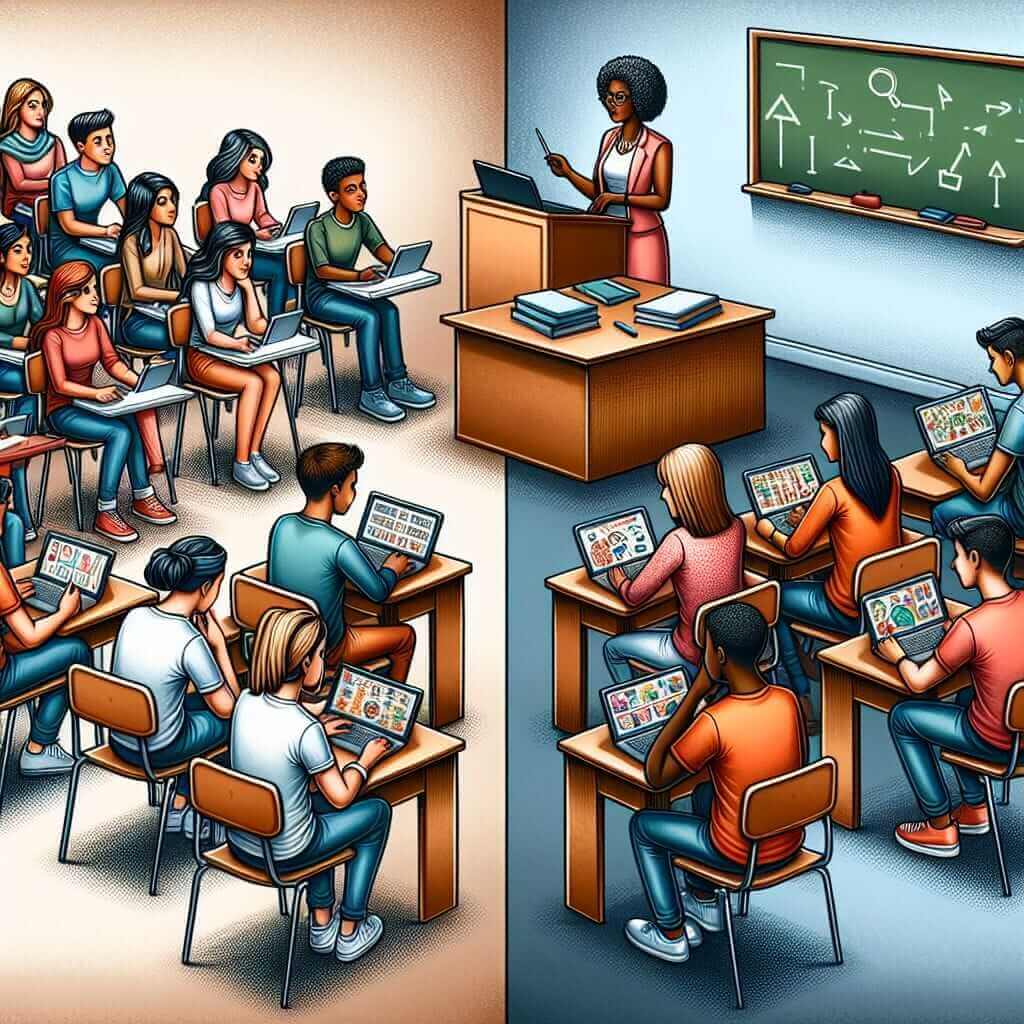The concept of “flipped classrooms” has gained significant traction in recent years, sparking debate about its effectiveness in educational settings. This approach, which reverses the traditional classroom model, has appeared in IELTS Writing Task 2, prompting test-takers to analyze its merits and drawbacks.
Here are some potential IELTS Writing Task 2 questions related to flipped classrooms:
- Some people believe that flipped classrooms, where students learn content online at home and practice in class, are more effective than traditional classrooms. Others argue that traditional classrooms are better. Discuss both views and give your opinion.
- The rise of online learning has led to an increase in the popularity of flipped classrooms, where students watch lectures at home and complete assignments in class. Do the advantages of this approach outweigh the disadvantages?
- Many educators argue that flipped classrooms allow for more personalized learning and increased student engagement. To what extent do you agree or disagree with this statement?
Sample Essay Analysis:
Let’s delve into a sample essay addressing the first question:
Question:
Some people believe that flipped classrooms, where students learn content online at home and practice in class, are more effective than traditional classrooms. Others argue that traditional classrooms are better. Discuss both views and give your opinion.
Analysis:
This question requires you to present a balanced discussion, exploring the arguments for and against flipped classrooms compared to traditional ones. You must provide your viewpoint after analyzing both sides.
Essay:
The traditional model of education, where teachers deliver lectures face-to-face and students primarily complete assignments at home, is being challenged by the emergence of flipped classrooms. This innovative approach posits that students can learn content more effectively through online materials outside of class, freeing up in-class time for interactive activities and personalized guidance. While proponents of flipped classrooms extol their benefits, others maintain that the traditional model remains superior.
Advocates of flipped classrooms argue that this method allows for greater student engagement and personalized learning. By providing students with access to lectures and learning materials online, they can learn at their own pace and revisit concepts as needed. This self-paced learning caters to individual learning styles and allows students to take ownership of their education. Moreover, with more class time dedicated to application and discussion, teachers can provide tailored support and address specific student needs. This interactive environment fosters deeper understanding and promotes active learning.
Conversely, critics of flipped classrooms contend that this approach can exacerbate existing educational inequalities. Not all students have equal access to technology or reliable internet connections at home, potentially putting them at a disadvantage. Furthermore, they argue that the traditional classroom setting, with its structured lectures and immediate teacher feedback, provides a stronger foundation for learning, particularly for students who require more guidance or have difficulty with self-directed learning.
In conclusion, while flipped classrooms offer potential benefits such as personalized learning and increased student engagement, concerns about equity and the importance of structured instruction remain valid. Ultimately, the effectiveness of either approach depends on various factors, including student demographics, subject matter, and the teacher’s ability to implement the chosen model effectively. A blended approach that combines the strengths of both traditional and flipped classrooms may provide the most comprehensive and equitable learning experience.
 Flipped Classroom vs. Traditional Classroom
Flipped Classroom vs. Traditional Classroom
Word Count: 288 words
Writing Notes:
- Structure: The essay follows a balanced discussion structure, addressing both sides of the argument before presenting a clear opinion.
- Vocabulary: The essay employs a range of vocabulary related to education and learning, such as “traditional model,” “flipped classrooms,” “personalized learning,” “student engagement,” and “structured instruction.”
- Grammar: The essay demonstrates accurate grammar usage, including complex sentence structures and a variety of grammatical structures.
- Coherence and Cohesion: The essay flows smoothly with clear topic sentences, logical progression of ideas, and appropriate use of linking words and phrases.
Vocabulary:
- Extol (verb): /ɪkˈstoʊl/ – To praise highly; glorify.
- Proponents (noun): /prəˈpoʊnənts/ – Supporters; advocates of a particular idea or course of action.
- Cater to (verb phrase): /ˈkeɪtər tu/ – To provide what is wanted or needed by a particular group of people.
- Exacerbate (verb): /ɪɡˈzæsərbeɪt/ – To make a problem, bad situation, or negative feeling worse.
- Equity (noun): /ˈɛkwɪti/ – Fairness; the quality of being fair and impartial.
Conclusion:
Mastering the art of discussing educational trends like flipped classrooms is crucial for success in IELTS Writing Task 2. By analyzing sample essays, expanding your vocabulary, and practicing your writing skills, you can confidently approach this topic and achieve your desired IELTS score. Remember to explore related themes such as online learning, technology in education, and the role of teachers in the 21st century to further enhance your understanding and writing proficiency.


